Top 7... things you probably didn't know about Half-Life 2
A life lived in ignorance is a life half-lived

On Sunday, November 16th 2014, Half-Life 2 turned 10 years old. Crazy, right? And even after a decade, the influence of Valve's most monumental sequel can still be felt in the current gaming ecosystem. The Half-Life name is just as potent today as it was in 2004, and even now, many revere HL2 as the greatest FPS ever made. Given that it's such a beloved, ubiquitous turning point within gaming's evolutionary lineage, you could assume that you've heard and seen all it has to offer by now. But you couldn't be more wrong.
Whether through behind-the-scenes details or incredibly cryptic in-game clues, Valve has hidden more secrets and fascinating details in Half-Life 2 than you can shake a crowbar at. But with so many tidbits of trivia and subplot minutiae out there, it can be tricky digging down to the really juicy stuff - the facts about Half-Life 2 that make you feel smarter than your fellow gamers just for knowing them. Luckily, I've compiled seven of the very best little-known facts about this beloved FPS epic and its episodic sequels, just for you. Prepare to have your mind blown.
7. G-Man is never actually referred to as such in-game
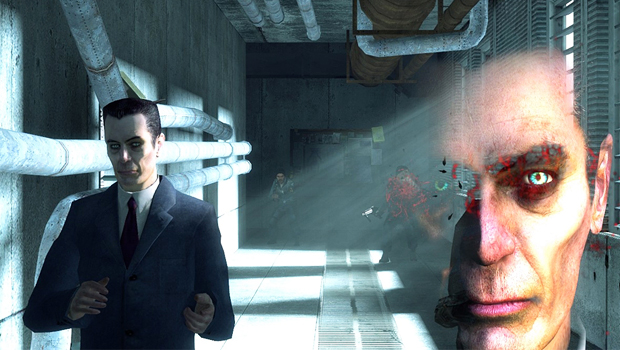
One of the most enigmatic figures in all of gaming is G-Man, the creepy, seemingly omniscient figure who's always keeping a watchful eye on Gordon Freeman. His gaunt appearance, detached demeanor, and bizarre speech inflections make him instantly recognizable. Any gamer worth their salt can identify the G-Man on sight. But amazingly, you really only know his name from hearsay - because the moniker "G-Man" is never seen or a heard a single time within the actual Half-Life universe.
It also goes back to the original Half-Life, where players derived the name G-Man from the label on his character model in the game code. The first game doesn't call out specific voice credits, either; it's not until Half-Life 2 that voice actor Michael Shapiro is credited as playing this morally ambiguous agent of the unknown. But the G-Man name stuck, and thank goodness for that - otherwise, discussing those myriad fan theories would be an absolute nightmare.
6. The secret All-Knowing Vortigaunt will regale you with songs of your past exploits
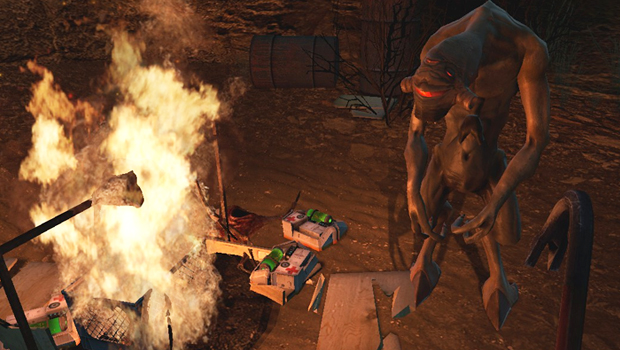
If you ever need a refresher on just how far Gordon's come since his days as a labcoat-clad cart-pusher, you should pay a visit to this hard-to-find Vortigaunt. In the fourth chapter of Half-Life 2, when you're in the driver's seat of a sick airboat, you might spot two suspicious-looking drain pipes near the end of the level. Position your airboat just so, and you'll be able leap gracefully from the handlebars into one of the grates, wading your way through toxic sludge before finding a secret cave on the other side.
It's here you'll find the All-Knowing Vortigaunt, a raspy alien who's enjoying a cooked headcrab meal all on his lonesome. He'll be humming like a Tibetan throat-singer as you approach, but once he notices you, he'll open your mind with some nuggets of deep wisdom and cryptic prophecy. Talk to him enough, and he'll also offer a mystical play-by-play of the final boss fight against the Nihilanth from the first game, making Gordon's battle against a giant alien baby sound positively poetic.
5. City 17 originally contained an Ender's Game-style arcade
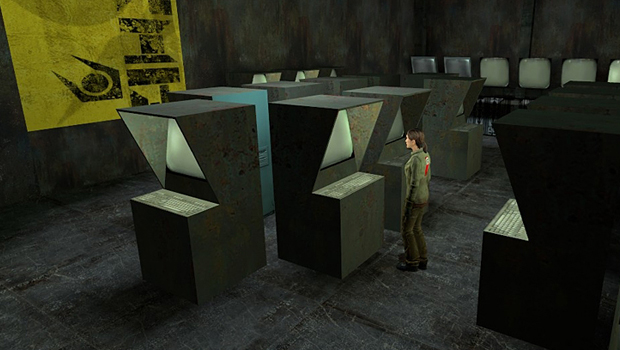
If you haven't read/watched/lived Ender's Game, one of its most fundamental concepts is (literary spoiler alert) a program that appears to be a battle simulation, but is actually a one-to-one representation of an interstellar war. Kids think that they're just racking up kills in a militaristic video game, but they're actually wiping out enemy combatants with remote-controlled ships in a far-off skirmish. Gordon Freeman was set to encounter a variation of this dark concept in the Manhack Arcade, a chunk of City 17 that didn't make it into the final game.
Weekly digests, tales from the communities you love, and more
Manhacks are those pesky flying drones that constantly accost Gordon in Half-Life 2, getting all up in his grill with their vicious spinning blades. The concept behind Manhack Arcade is that it would be a space for oppressed citizens to blow off some steam and try to nab a high score in a popular video game, in which you control a Manhack as it slices up fugitives. Of course, they'd be completely unaware that playing meant that they were actually mutilating real people on City 17's streets, and therein lies the horror. The Manhack Arcade was designed and redesigned no less than three times before eventually being left on the cutting room floor.
4. Alyx's brush with death in Episode Two used to be something else entirely
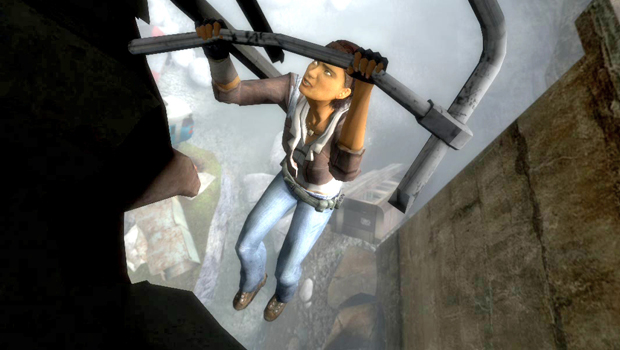
After growing so attached to Alyx Vance over the course of Half-Life 2, it's utterly devastating when Gordon has to watch helplessly as she's viciously attacked by an alien Hunter. This scene is a masterstroke in how to sway a gamer's emotions, as you're immediately overcome by rage at the Hunter for impaling your loyal, lovely companion in the back. But this moment wasn't always so poignant - because if you remember the original Episode Two trailer, Alyx was supposed to be injured by a calamitous fall.
After the train crash that concludes Episode One, Gordon was to wake to Alyx calling for help as she dangled above a treacherous drop. No matter what the player did, they wouldn't be able to aid her in time, an illogically scripted situation which was found to be both confusing and upsetting during playtests. Not only did it not make sense that Gordon would be powerless to extend a hand - there was no entity to be mad at or want revenge on, besides maybe gravity. That was all corrected by reorienting the scene to revolve around the Hunter, because good God did I want to murder that thing.
3. Episode Two makes a ridiculously obscure reference to the first ten minutes of the original Half-Life
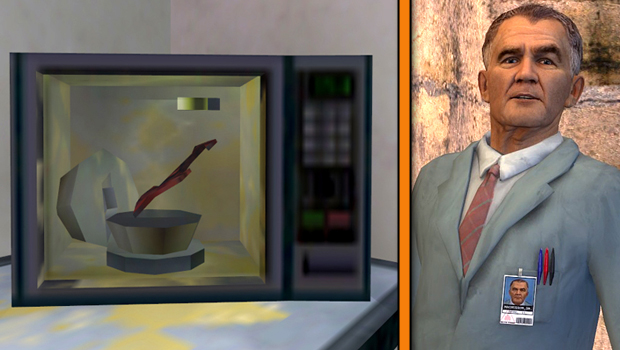
You might not remember Dr. Arne Magnusson, the supporting character from Half-Life 2: Episode Two who designs technological marvels for the Resistance. His most notable trait (aside from his huge ego) is that he too is a survivor of what happened at Black Mesa, and was an associate of Eli Vance and Dr. Kleiner before the events of the first Half-Life. And just before he sends Gordon off on one of his many daring escapades, Magnusson tells Freeman "If you pull this off, I might just forgive you for that debacle at Black Mesa. You know the one I mean... involving a certain microwave casserole." Say what?
This is actually a ludicrously deep-cut reference to a vignette in the first Half-Life, when Gordon is free to explore the more mundane sectors of the Black Mesa facility. Being able to interact with objects was a big deal back then, so of course you'd want to fiddle with the microwave in the scientists' break room. Of course, jamming the power button too many times causes the meal inside to explode - and wouldn't you know it, it was Magnusson's lunch that you ruined all those years ago.
2. Chell's boots in Portal started out as Combine technology
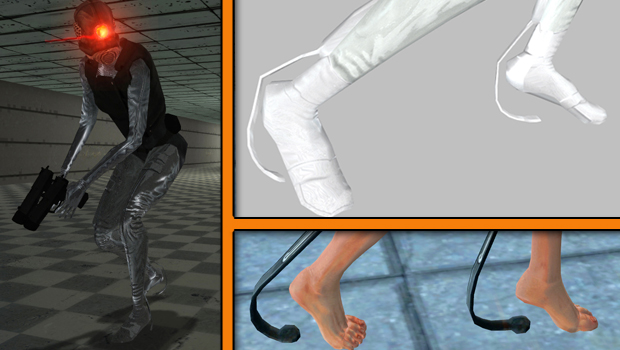
The first time you played Portal, you no doubt fashioned a makeshift, physics-defying portal mirror to get a good look at your character, Chell. And the first thing you probably noticed were those weird doohickeys clamped onto Chell's calves. Those would be the Advanced Knee Replacements, an Aperture technology that nullifies the impact of drops that would otherwise shatter your leg bones into a fine powder. And while they look positively fabulous on Chell, they were originally intended for use by the Combine.
There was a time when Half-Life 2 included enemies called Combine Assassins, which were the spiritual successors to the nimble, latex-clad Black Ops commandos from the first Half-Life. These femme fatales were designed to be incredibly acrobatic, flipping and dashing all over the place with the help of their prosthetic heel attachments. Ultimately, this enemy type was scrapped, but their fancy footwear would live on as Chell's springy Advanced Knee Replacements and the even-more-stylish Long Fall Boots in the Portal series.
1. It's possible that Gordon is actually speaking the entire time
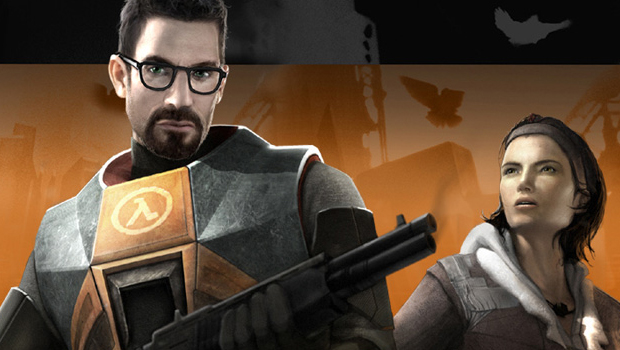
Put on your thinking caps, folks, because I'm about to ask that you ponder some wildly theoretical possibilities. Valve has stated time and again that they purposely created Gordon Freeman without a voice to better immerse the player; to make it feel as though this adventure is actually happening to you instead of a virtual character. Giving Gordon dialogue would instantly break the illusion that he exists as your avatar, since it would inevitably create a disconnect between what you're thinking and what Gordon's saying. But just because you can't hear him, doesn't mean Gordon's totally mute.
The script in Half-Life 2 is carefully written to account for Gordon's silence - but despite being a "man of few words," as Alyx jokes, it's implied that he might actually be saying whatever you, the player, is thinking at the time. Why else would Barney Calhoun ask, "If you see Dr. Breen, tell him I said 'Fu-- -ou!!'", and how could Gordon commanded entire squads of Resistance fighters without a single utterance? Audio designer Kelly Bailey has stated that "Our intent was that Gordons voice is your own voice - its whatever you hear in your own head as you play." This one's up to interpretation - but the mere notion of a not-so-silent Gordon is delicious food for thought.
"We remember the Freeman"
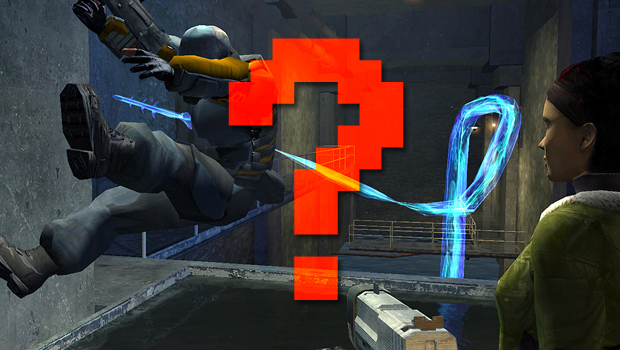
Hopefully you learned a thing or two that you didn't already know about Half-Life 2, besides the obvious trivia (like what the Headcrab Zombies are saying backwards, or the almost-made-it Hydra enemy pictured above). If not, consider yourself a hardcore Half-Life guru! Are there any other fascinating stories you'd like to impart now that Half-Life 2 is a decade old? Share and share alike in the comments below.
And for more Half-Life reminiscing, check out Why Half-Life 2 is still the greatest FPS ever made, 10 years on and The many ways Half-Life 2 changed gaming forever.
Lucas Sullivan is the former US Managing Editor of GamesRadar+. Lucas spent seven years working for GR, starting as an Associate Editor in 2012 before climbing the ranks. He left us in 2019 to pursue a career path on the other side of the fence, joining 2K Games as a Global Content Manager. Lucas doesn't get to write about games like Borderlands and Mafia anymore, but he does get to help make and market them.



